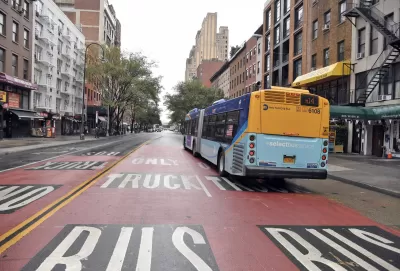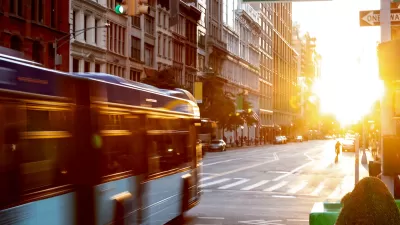New York City’s Metropolitan Transportation Authority is renewing efforts to create more bus lanes and dedicated busways in the city.

“In January 2021, the busiest portion of Flushing’s Main Street became a ‘busway,’ meaning only buses, trucks and emergency vehicles are allowed past a certain point,” writes John Surico for Bloomberg CityLab. “Within months, the city reported speed gains of up to 31%. As of May, it’s up 50% at the afternoon peak, according to a city Department of Transportation spokesperson.”
As Surico describes, “The busway treatment was part of Better Buses Restart, the reactivation of New York City’s service improvement plan from 2018, which screeched to a halt in March 2020.” Prior to the plan, “The five-borough network hadn’t been touched in decades, leaving the system out of sync with where New Yorkers were actually going; work and living patterns have shifted dramatically, a process that the pandemic accelerated further.”
However, “Like the subway, New York’s buses are trapped in a jurisdictional battle: the (state) MTA controls the routes and fleet, but the (city) DOT is in charge of the streets. Knowing who controls what can be tricky. And collaboration can leave much to be desired: The MTA called for 60 miles of new bus lanes, but so far the city has only delivered about 20 miles.” Last August, DOT and MTA pledged to build or improve 20 new miles of bus lanes or busways in 2022. “DOT officials said the major focus this year will be the Bronx, given the redesign launch in June. They are also rolling out bus priority projects in Manhattan and Queens, and more busways are in development.”
Advocates warn that “Finding a way to keep cars out of bus- and truck-only corridors is critical to making them work,” and the MTA is investing in automated traffic enforcement to crack down on drivers who illegally enter bus lanes.
Last year, the agency also introduced a contactless payment system that streamlines onboarding and reduces the time buses are stopped as passengers board, although the program’s all-door boarding component has not yet been put into action.
“In interviews, advocates seem both motivated and anxious by the progress that the system has made, and the scale of the work still left to do.” While the system is still well below pre-pandemic ridership revenue, the MTA expects to receive millions once the city launches its congestion pricing program.
FULL STORY: How New York City Plans to Speed Up its Buses

Alabama: Trump Terminates Settlements for Black Communities Harmed By Raw Sewage
Trump deemed the landmark civil rights agreement “illegal DEI and environmental justice policy.”

Study: Maui’s Plan to Convert Vacation Rentals to Long-Term Housing Could Cause Nearly $1 Billion Economic Loss
The plan would reduce visitor accommodation by 25% resulting in 1,900 jobs lost.

Planetizen Federal Action Tracker
A weekly monitor of how Trump’s orders and actions are impacting planners and planning in America.

Restoring Northern India’s Himalayan ‘Water Temples’
Thousands of centuries-old buildings protect the region’s natural springs and serve as community wells and gathering places.

Milwaukee to Double Bike Share Stations
Bublr Bikes, one of the nation’s most successful, will add 500 new e-bikes to its system.

DC Extends Application Window for Outdoor Dining Permits
District restaurants will have until the end of November to apply, but businesses with permits in rush hour parking lanes must end operations on July 31.
Urban Design for Planners 1: Software Tools
This six-course series explores essential urban design concepts using open source software and equips planners with the tools they need to participate fully in the urban design process.
Planning for Universal Design
Learn the tools for implementing Universal Design in planning regulations.
Caltrans
Smith Gee Studio
Institute for Housing and Urban Development Studies (IHS)
City of Grandview
Harvard GSD Executive Education
Toledo-Lucas County Plan Commissions
Salt Lake City
NYU Wagner Graduate School of Public Service





























